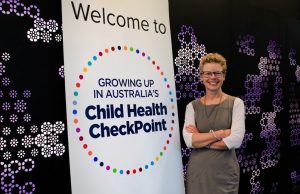

Around the year 2000, governments all around the world got excited about children: specifically, the children of the new millennium. Countries announced ambitious national longitudinal cohorts, recruited at birth, before birth, and even before conception.
Australia’s good fortune came in the shape of the Longitudinal Study of Australian Children (LSAC). LSAC, also known as Growing Up in Australia, is Australia’s largest and only nationally representative children’s longitudinal study.1,2 Approximately 5000 children aged 4-5 years and 5000 children aged 0-1 years were recruited to the study in 2004. LSAC has now collected six biennial waves of social, economic, and physical health data, with another wave occurring this year.
LSAC has a number of design features that make it an invaluable resource.
Its data are accessible to all researchers, and core measures (such as mental health, health-related quality of life) are widely used internationally, to support cross-country research into how culture and policy impact on health and other outcomes.
Linkage with existing national datasets, including Medicare (MBS, PBS), immunisation, and national literacy/numeracy assessments (NAPLAN), add multiple axes along which data can be combined to address new and creative questions.
LSAC is already highly productive with, at time of writing, more than 1700 data applications received.
Designed to examine “the impact of Australia’s unique social, economic and cultural environment on the next generation”, LSAC has aimed from the outset “to provide a strong evidence base for policy development and service delivery on a wide range of issues relating to children’s development”2.
Information exchange is supported by its ongoing partnership arrangements: LSAC is jointly conducted by the Australian Department of Social Services, the Australian Institute of Family Studies and the Australian Bureau of Statistics, while the Consortium Advisory Group is a multidisciplinary team of researchers that largely drives the science of the study.
Influencing policy
How successfully has LSAC managed to influence policy?
This can’t be answered directly, because most policy is developed on the basis of an accumulation of evidence, and only those directly involved in any given policy have insight into exactly what evidence is used. However, some examples include:
- In its review of Australia’s welfare system, the 2015 McClure Report highlighted LSAC, describing longitudinal data as vital information to use in policy making and to direct essential early intervention services for children and young people
- Within the Productivity Commission’s report into the state of child care, LSAC data highlighted factors influencing the developmental outcomes of children such as attendance at preschool, hours spent in care and family characteristics
- The Productivity Commission’s report into Paid Parental Leave used LSAC data about numbers of Australian mothers and fathers with/without access to paid and unpaid parental leave; in paid work before their child’s birth; and the amount and type of leave after the birth
- The Australian Human Rights Commission Children’s Rights Report 2015 included data on the impact of domestic violence on children from LSAC and the parallel Longitudinal Study of Indigenous Children.
LSAC is among an international pantheon of millennial studies, which includes the English Millenium Cohort Study (MCS, 2000), Growing Up in Scotland (GUS, 2005), Growing Up in Ireland (GUI, 2007) andGrowing Up in New Zealand (GUiNZ, 2008). All are government funded and they share methods and measures.
Intriguingly, each sits within its country’s social, rather than health, research framework, perhaps because as a society we see children as inherently healthy, and disease as something for older people. As a result, until now, none of these studies has focused on direct health measurements or biosamples beyond simple measures such as height and weight.
Broadening the evidence-base
This does impose policy limitations in an era when diseases of ageing increasingly drive the world’s burden of disease. The seeds of these non-communicable diseases – characterised by slow progression and long duration – are sown in childhood. They have related determinants and often cluster in individuals and families.
It is believed that family, social and environmental experiences all interact with the child’s innate biology to create shared modifiable pathways (such as chronic inflammation) to multiple diseases. Precursors of these diseases are already measurable as wide gradients of normal across many body systems in healthy children.
LSAC’s bold response to this “public health emergency in slow motion” was to support a group of senior health researchers to leverage additional funding* in a unique one-off addition to the study.
Throughout 2015, the Child Health CheckPoint3 invited the LSAC 11‒12 year olds from the original baby cohort to attend a purpose-built assessment centre as it travelled around Australia. Each child and their accompanying parent undertook multiple state-of-the art health measurements and provided biosamples (blood, saliva, hair, urine) during a busy 3.5 hour session.
By March 2016, nearly 2000 parent-child dyads had taken part, with the resulting digital and biological resource housed at the Murdoch Childrens Research Institute. As its data are progressively extracted, the Australian Institute of Family Studies will release them for the use of all researchers, linked to the ever-growing longitudinal LSAC dataset.
The Child Health CheckPoint targets multiple Australian health priorities. It will show how biology, environment and psychology “get under the skin” during childhood and midlife via physiological adaptations that ultimately lead to the major causes of death and morbidity.
It is hoped that its findings will inform public health and service strategies that lessen the future burden of non-communicable diseases.
References
- Nicholson JM, Sanson, A. A new longitudinal study of the health and wellbeing of Australian children: How will it help? Medical Journal of Australia 2003;178(6):282–284.
- Sanson A, Johnstone R, The LSAC Research Consortium & The FaCS LSAC Project Team. Growing Up in Australia takes its first steps. Family Matters 2004;67: 46–53.
- Wake M, Clifford S, York E, Mensah F, Gold L, Burgner D, Davies S, and the Child Health CheckPoint investigators. Introducing Growing Up in Australia’s Child Health CheckPoint: A physical health and biomarkers module for the Longitudinal Study of Australian Children. Family Matters 2014;95:15‒23
*Acknowledgements:
The Child Health CheckPoint is led from the Murdoch Childrens Research Institute. It gratefully acknowledges the assistance of the Australian Department of Social Services, the Australian Bureau of Statistics, and Australian Institute of Family Studies; funding from the NHMRC, Foundation for Children, National Heart Foundation, Murdoch Childrens Research Institute, Royal Children’s Hospital Foundation and The University of Melbourne; and the research institutes, benefactors and supporters around Australia who generously provided the in-kind assistance that made the CheckPoint possible.
Professor Wake would also like to acknowledge the full team of CheckPoint investigators.3
